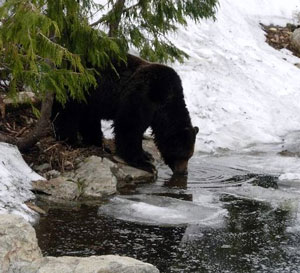Montane Wildlife - Grizzly Bear
GRIZZLY BEAR
Grizzlies are usually "thee animal" people wish to see here in the Rockies, but to tell you the truth, we locals are glad when we don't cross paths.
Although the grizzly is not a fierce, blood-thirsty predator as is commonly believed, it is a wild and unpredictable animal - not to mention very large and extremely quick.
In the summer months grizzlies can often be seen enjoying berries and wildflowers along the Icefields Parkway. They also claw and dig at the earth under logs and rocks in the hopes of finding some tasty ants.
HOW DO I KNOW I HAVE SEEN A GRIZZLY AND NOT A BLACK BEAR?

Thirsty Grizzly
Dominik Wegener
The grizzly has the following traits:
- shoulder hump
- longer snout
- smaller ears
- rounder head, concave face
- long claws, easy to see
whereas the black bear has the following:
- no shoulder hump
- shorter snout
- larger ears
- long head
- short claws
Despite what you may see in books or on postcards, grizzlies vary in colour and may be black, brown, light brown, reddish-brown or even white.
A GRIZZLY LIFE
A grizzly bear depends on high-energy food and spends the majority of their time in search of such food. It is of utmost importance for the grizzly to gain enough body fat to sustain itself over the long and cold winter, during which it hibernates. In early April it is time for it to wake up from its long winter sleep.
A grizzly bear is considered an omnivore, which means its diet consists of plants as well as animals. Here are some grizzly favourites:
- Spring: roots, new green grass, flowers and leaves from such plants as the dandelion
- Summer: berries (like buffalo berries), wildflowers
- Fall: roots, fish (salmon is especially desired!)
- Insects are also an exciting snack!
- Although a grizzly's diet is mostly vegetarian in nature, it is also common for grizzlies to enjoy the odd small animal such as a ground squirrel or marmot. If a grizzly finds a larger weakened or young animal such as a deer or elk, it will often try to take it down. If a grizzly is lucky, it may come across a kill site of a wolf pack - which it will of course take over!! Unfortunately they may also feed on young grizzly cubs - even if they are their own!
After a delicious spring, summer and fall, when November's cold is upon us, the grizzly tucks itself into its subalpine den for its winter hibernation. If the female grizzly has been inseminated and has gained enough weight to potentially sustain herself and the cubs, the fertilized eggs will attach to her uterine wall and she will give birth in the den during the period of hibernation. If she has not gained enough weight, the fertilized egg will not implant. There are usually 1-3 cubs in a litter. Females mate about every three years, giving themselves time to raise their young.
A grizzly bear requires large corridors in which to travel. It travels through montane as well as subalpine areas and enjoys a variety of landscapes, each with its own advantages for the grizzly. Burnt forests offer the grizzly lush forest floors due to abundant sunlight where berry bushes thrive and ants are plentiful. Avalanche areas may produce an unexpected meal of fresh mountain goat meat. Rivers and streams give the grizzly an opportunity to fish, and roadside ditches are filled with sunny-coloured dandelions. Mmm Mmm...
WHAT DOES THE FUTURE HOLD FOR OUR GRIZZLIES?
To be honest, it doesn't look good. Alberta Sustainable Resource Development (SRD) officials have projected that their numbers are going to stay as they are now if something isn't done. Right now it is believed that there are about 230 bears from the Montana border to the Jasper/Hinton region. There could be up to 400 in the entire province of Alberta. This is under the predicted number of 800-1000 which was made many years ago. At this point we can only hope that the Alberta government steps up and protects this endangered bear, at least until we have reached the minimum 1000 adults which the International Union for the Conservation of Nature (IUCN) believes is required to have a healthy gene pool for the bear's future.




